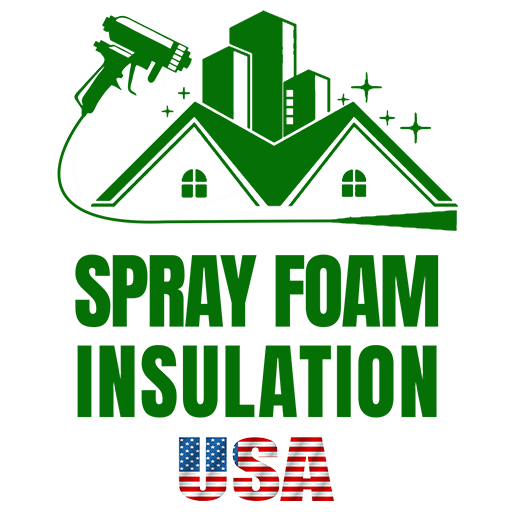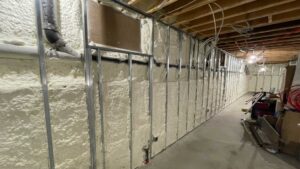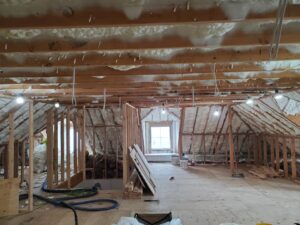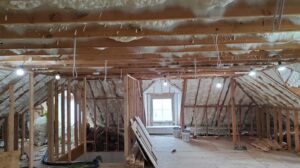Introduction
When energy efficiency is not just a buzzword but a necessity, thermal insulation stands out as a hero. It’s the unseen force that keeps our homes warm in the chilly winters and cool during the scorching summers. But beyond the comfort, it plays a pivotal role in slashing those hefty energy bills and contributing to a greener planet.
Thermal insulation is essentially like wrapping your home in a cozy blanket that blocks unwanted heat exchange. This means less energy is required to heat or cool your space, leading to significant savings and a smaller carbon footprint. For homeowners and business owners in NY and NJ, understanding the basics of thermal insulation is the first step towards achieving year-round comfort, energy efficiency, and sustainability.
- Quick Answers for the Busy Reader:
- Importance: Keeps homes comfortable, reduces energy bills, lowers carbon footprint.
- Energy Efficiency: Less heat loss in winter, less cooling needed in summer.
- Solutions: From fluffy fiberglass to cutting-edge spray foams.
Whether you’re tackling a drafty attic or building from scratch, choosing the right insulation is key. Below, we’ve created an infographic to guide you through the options, why they matter, and how they can benefit your home or business.

Understanding the role of thermal insulation in your home is just the beginning. Ahead, we’ll dive deeper into the types of insulation, their benefits, and how to choose the best option for your needs. Let’s embark on this journey to a more comfortable, energy-efficient home together.
Understanding Thermal Insulation
When we talk about keeping our homes cozy and cutting down on energy bills, thermal insulation is the superhero we often overlook. But what exactly is it, and how does it work its magic? Let’s break it down.
Types of Thermal Insulation
There are several types of insulation, each with its unique properties and applications. Here’s a quick overview:
- Fiberglass: This type is made from fine glass fibers and is commonly used in batts, rolls, and loose-fill insulation.
- Mineral Wool: Includes rock and slag wool and can be used in similar applications as fiberglass.
- Cellulose: Made from recycled paper products and is typically blown into attics and walls.
- Foam Board: Rigid panels of insulation that can be used on walls, roofs, and foundations.
- Spray Foam: Applied wet and expands into a thick foam, sealing leaks and adding insulation.
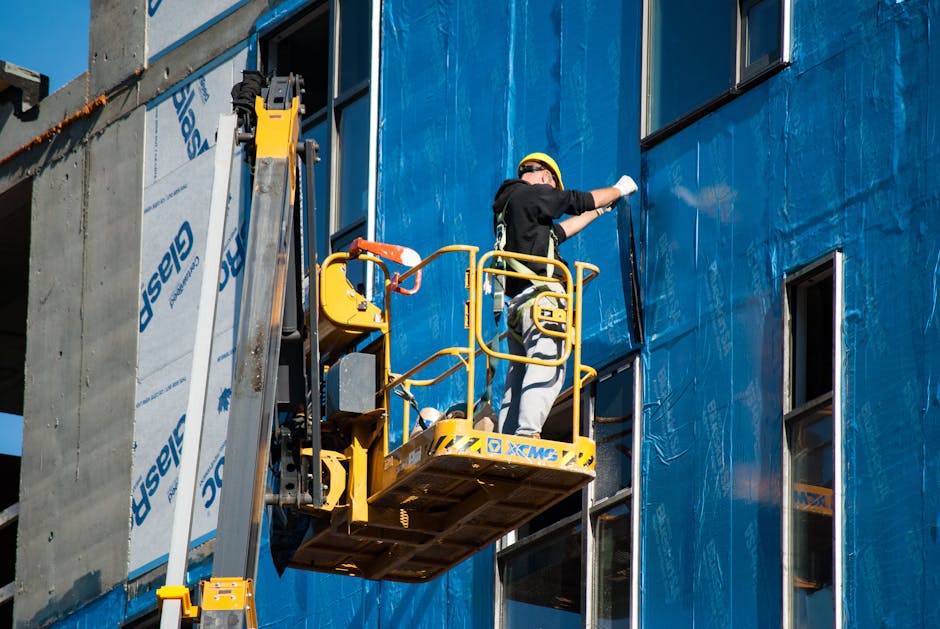
Benefits of Thermal Insulation
Insulating your home comes with a host of benefits:
– Energy Efficiency: Proper insulation keeps your home warmer in the winter and cooler in the summer, reducing the need for heating and cooling.
– Cost Savings: By improving your home’s energy efficiency, you’ll see a noticeable decrease in your utility bills.
– Comfort: Insulation helps maintain a consistent temperature throughout your home, eliminating cold spots and drafts.
– Environmental Impact: Using less energy means fewer carbon emissions, making insulation a green choice for your home.
Understanding R-values
The effectiveness of insulation is measured by its R-value, which indicates its resistance to heat flow. The higher the R-value, the better the insulation performs. When choosing insulation:
- Check the recommended R-values for your area based on the climate.
- Consider the application area. Attics, walls, and floors might require different R-values for optimal performance.
- Think about the type of insulation. Some materials have higher R-values per inch than others, which can be crucial in spaces where thickness is limited.

Choosing the right thermal insulation solution involves understanding the types available, the benefits they offer, and the importance of R-values in determining their effectiveness. With the right insulation, you can enjoy a more comfortable home, lower energy bills, and a reduced environmental footprint.
We’ll explore the most efficient materials for insulation, common options for everyday use, and innovative solutions that are changing the game. Whether you’re a DIY enthusiast or planning to hire professionals, understanding these basics will help you make informed decisions about insulating your home.
Most Efficient Thermal Insulation Materials
When we talk about thermal insulation solutions, a few materials stand out because of their exceptional efficiency. Let’s dive into three of the most effective insulators: Aerogel, Pyrogel, and Vacuum insulation. Each of these materials has unique properties that make them stand out in insulation.
Aerogel
Imagine a material so light, it feels almost like air. That’s Aerogel for you. It’s one of the lightest solid materials on the planet, made by removing the liquid from a gel. What’s left is a network of tiny pores that trap air, making it an incredible insulator. Aerogel’s effectiveness comes from its ability to minimize the three methods of heat transfer: conduction, convection, and radiation. It’s often used in specialized applications like aerospace, but it’s also finding its way into homes for super-efficient insulation.
Pyrogel
Pyrogel is a bit like Aerogel’s tough cousin. It’s flexible, easy to handle, and incredibly resistant to high temperatures. This makes Pyrogel an excellent choice for insulating pipes and other industrial applications where heat resistance is crucial. Just like Aerogel, Pyrogel works by trapping air in a porous structure, but it’s designed to be more durable and resistant to physical stress.
Vacuum Insulation
Now, let’s talk about Vacuum insulation. If you’ve ever used a thermos to keep your coffee hot, you’ve seen vacuum insulation in action. This type of insulation uses a vacuum space to reduce heat transfer. No air means no conduction or convection can take place. Vacuum insulation panels are among the most efficient thermal insulation solutions available, offering up to ten times the insulating performance of traditional materials like fiberglass or foam.
Choosing the right insulation material can feel like a daunting task, but understanding the properties and applications of these efficient insulators can help you make an informed decision. Whether you’re building a new home, upgrading your current one, or working on a special project, consider these high-efficiency options for the best thermal performance. The goal is to keep your space comfortable while minimizing energy use and your environmental footprint.
We’ll look into common insulators used in everyday settings and introduce some innovative insulation solutions that are making buildings more energy-efficient than ever.
Common Thermal Insulators for Everyday Use
In the quest for a cozy and energy-efficient home, selecting the right insulation is crucial. Let’s dive into some familiar faces in the insulation world: Fiberglass, Mineral Wool, Polyurethane Foam, and Polystyrene.
Fiberglass
Fiberglass is like the friendly neighbor everyone knows. It’s made from tiny glass fibers and is one of the most common insulators you’ll find in homes today. Why? Because it’s effective and affordable. Fiberglass traps air pockets, slowing down the spread of heat, cold, and sound. Plus, it’s pretty versatile, fitting snugly into walls, attics, and floors. But, remember to wear protective gear when handling it – those tiny fibers can be itchy and irritating.
Mineral Wool
Next up, Mineral Wool. This isn’t just one material but a group, including rock wool and slag wool. Think of mineral wool as the tough cookie of insulation. It’s made from rock, furnace slag, and other raw materials. This gives it superpowers like being fire-resistant and great at blocking sound. It’s a bit pricier than fiberglass but worth it if you need that extra oomph against noise or fire.
Polyurethane Foam
Polyurethane Foam is the superhero of the insulation world. It comes in two forms: spray foam and rigid foam boards. Spray foam expands to fill every nook and cranny, creating an airtight seal. This makes it a champion at stopping air leaks and keeping your home’s temperature steady. It’s also moisture-resistant, which helps prevent mold. Rigid foam boards are perfect for insulating basements and exterior walls. While polyurethane foam might cost more upfront, its stellar performance can save you money on energy bills in the long run.
Polystyrene
Lastly, we have Polystyrene. You might know it better as Styrofoam. Polystyrene comes in two types: expanded (EPS) and extruded (XPS). Both are lightweight and excellent at resisting moisture, making them great for insulating foundation walls and beneath floors. Plus, they’re relatively easy to install. However, be mindful of the environmental impact, as polystyrene isn’t the greenest option out there.
Choosing the right insulation from these common materials depends on your specific needs, budget, and the area you’re insulating. Fiberglass and Mineral Wool offer great bang for your buck for basic home insulation. Polyurethane Foam excels in sealing air leaks and insulating tricky spots. Polystyrene is your go-to for moisture-prone areas, though it’s less eco-friendly.
We’ll explore some innovative insulation solutions that push the boundaries of energy efficiency. These advancements are making buildings smarter, greener, and more comfortable than ever before.
Best Natural Thermal Insulators
When it comes to keeping your home warm in the winter and cool in the summer, not all insulation is created equal. Some materials, like wool, cotton, and sheep’s wool, stand out for their natural thermal insulation properties. Let’s dive into why these materials are top choices for eco-conscious homeowners.
Wool
Wool is a powerhouse when it comes to insulation. This natural fiber has an incredible ability to trap air, making it an excellent insulator. What’s more, wool is moisture-resistant, meaning it can help manage humidity levels in your home. This is crucial for preventing mold growth and ensuring a comfortable indoor climate.
Cotton
Cotton might be more familiar to us as clothing material, but it’s also a fantastic insulator. Recycled cotton, often sourced from denim fabric, is becoming a popular eco-friendly insulation choice. It’s soft, safe to handle, and has a low environmental impact. Plus, cotton has good thermal properties and sound absorption, making it a quiet winner for home insulation.
Sheep’s Wool
Sheep’s wool, similar to the wool mentioned earlier but specifically from sheep, is another excellent natural insulator. It’s renewable, biodegradable, and has a low carbon footprint. Sheep’s wool can absorb and release moisture without compromising its thermal insulation properties. This dynamic ability helps regulate indoor humidity levels, contributing to a healthier living environment.
These natural thermal insulation solutions offer a blend of energy efficiency, sustainability, and indoor comfort. While they might come with a higher upfront cost compared to synthetic materials, the long-term benefits for your home, health, and the planet are worth considering.
As we continue to explore insulation, the right choice depends on your specific needs, climate, and budget. Whether you’re leaning towards natural materials or innovative solutions, the goal is the same: to create a more energy-efficient and comfortable home.
In the next section, we’ll delve into some of the most innovative insulation solutions on the market. From spray foam to reflective systems, these advanced options are reshaping how we think about insulating our homes. Stay tuned to learn how these technologies can help you save energy and reduce your carbon footprint.
Innovative Insulation Solutions
In the realm of thermal insulation, innovation is key to achieving superior energy efficiency and sustainability. Let’s explore some of the most cutting-edge thermal insulation solutions available today: Spray Foam, Reflective Systems, Structural Insulated Panels (SIPs), and Insulating Concrete Forms (ICFs).
Spray Foam Insulation
Spray Polyurethane Foam (SPF) stands out as a insulation method. Unlike traditional materials, SPF expands upon application, filling even the smallest gaps and crevices. This creates an airtight seal, drastically reducing energy loss. Its high R-value per inch means it provides excellent thermal resistance with less material. Plus, SPF insulation is not only about keeping your space warm or cool; it’s also about creating a healthier living environment by keeping out pollutants and allergens.
Spray Foam Insulation USA, a leader in this field, emphasizes the dual benefits of SPF: immediate savings on heating and cooling costs and a noticeable improvement in indoor air quality. Their ECOTIF500® product is a testament to the effectiveness and eco-friendliness of SPF insulation.
Reflective Systems
Reflective insulation systems work by reducing radiant heat transfer, keeping your home cooler in the summer and warmer in the winter. These systems typically involve aluminum foils that reflect heat away from the living space. They’re particularly effective in hot climates and in buildings where direct sunlight is a significant factor in heat gain. By reflecting radiant heat, these systems help maintain a consistent temperature, enhancing comfort without overburdening the HVAC system.
Structural Insulated Panels (SIPs)
SIPs are a game-changer in building construction. These panels consist of an insulating foam core sandwiched between two structural facings, typically made of oriented strand board (OSB). This design not only provides superior insulation but also adds to the structural integrity of buildings. SIPs allow for faster construction times, reduced labor costs, and significant energy savings—12% to 14% compared to traditional methods. They create a more airtight dwelling, making homes quieter and more energy-efficient.
Insulating Concrete Forms (ICFs)
ICFs are forms for poured concrete walls that stay in place as a permanent part of the wall assembly. The forms, made of foam insulation, are either pre-formed interlocking blocks or separate panels connected with plastic ties. ICFs offer a robust thermal barrier, significantly reducing heating and cooling costs. Additionally, buildings constructed with ICFs are known for their strength, durability, and resistance to natural disasters. This makes ICFs an ideal choice for areas prone to severe weather.
In conclusion, these innovative insulation solutions offer a range of benefits from energy savings to improved structural strength. Whether you’re building a new home or upgrading an existing one, considering these options can lead to long-term savings and enhanced comfort. Spray Foam Insulation USA can guide you through choosing the right insulation method for your needs, ensuring that you achieve the best possible outcome for your project.
Let’s address some common questions about thermal insulation solutions, including their purpose, contribution to energy efficiency, and the most eco-friendly materials available.
Installation and Professional Services
When it comes to installing thermal insulation in your home, you have two main paths: do-it-yourself (DIY) or hiring professionals. Both options have their place, but the choice depends on the type of insulation, your comfort level with home improvement projects, and the complexity of the area you’re insulating. Let’s dive into some DIY tips and advice on hiring professionals, with a special focus on Spray Foam Insulation USA.
DIY Tips
Safety First: Always wear protective gear. Insulation materials can be irritating to the skin and lungs.
Understand R-values: Before starting, know the recommended R-values for your area. This ensures your insulation will be effective.
Seal Air Leaks: Insulation is most effective when air leaks are sealed. Use caulk or weather-stripping around doors, windows, and other leak-prone areas.
Follow Instructions: If you’re using materials suitable for DIY, like fiberglass batts, follow the manufacturer’s instructions closely to avoid common pitfalls like compression or gaps.
Hiring Professionals
Get Multiple Quotes: Insulation costs can vary widely. Obtain several estimates to ensure you’re getting a fair price for the R-value you need.
Check Experience: Ask about the contractor’s experience with the specific type of insulation you’re considering. Proper installation is crucial for performance.
Ask About Air Sealing: Combining insulation with air sealing can significantly increase your home’s energy efficiency. See if this service is offered.
Consider Spray Foam Insulation USA: For projects requiring professional-grade materials like spray foam, turning to experts like Spray Foam Insulation USA is a smart choice. Their comprehensive evaluation guarantees that all crucial areas are addressed, maximizing energy efficiency and comfort.
Spray Foam Insulation USA stands out for several reasons:
– Customized Solutions: They assess your home to tailor the insulation solution to your specific needs.
– Energy Efficiency: Spray foam creates a tight barrier that prevents heat loss and minimizes outside air infiltration, leading to significant energy savings.
– Expert Installation: Professional installation ensures the insulation is applied correctly, maximizing its effectiveness and longevity.
Conclusion
Whether you decide to tackle insulation as a DIY project or hire professionals, the key is to choose the right materials and ensure they’re installed correctly. For complex projects or to achieve the highest energy efficiency, professional services like Spray Foam Insulation USA offer valuable expertise and peace of mind. The goal is not just to insulate but to enhance your home’s comfort and reduce energy costs in the long run. As we explore further into thermal insulation solutions, keep these tips in mind to make informed decisions for your home.
Next, we’ll dive into some frequently asked questions about thermal insulation solutions, shedding light on their purpose, how they contribute to energy efficiency, and spotlighting the most eco-friendly materials available.
Frequently Asked Questions about Thermal Insulation Solutions
When it comes to keeping your home cozy and your energy bills low, thermal insulation solutions are your best friend. But what exactly is thermal insulation, and why is it so important? Let’s break down some of the most common questions to give you a clearer picture.
What is the purpose of thermal insulation?
Simply put, thermal insulation is like a snug blanket for your house. It helps keep the warmth in during winter and out during summer. This means your heating or cooling systems don’t have to work as hard, making your home more comfortable year-round. It’s not just about comfort, though. Thermal insulation also plays a big part in reducing energy consumption, which is good for both your wallet and the planet.
How does thermal insulation contribute to energy efficiency?
Think of your home as a thermos. Without proper insulation, heat escapes in the winter and sneaks in during the summer, making your heating and cooling systems work overtime. This not only increases your energy bills but also your carbon footprint. By adding thermal insulation, you’re effectively slowing down the movement of heat, which means less energy is needed to maintain your desired indoor temperature. The U.S. Department of Energy highlights that you could cut your heating and cooling expenses by up to 15% with proper attic insulation alone. That’s a significant saving!
What are the most eco-friendly insulation materials?
In our quest for sustainability, choosing eco-friendly insulation materials has become more important than ever. Here are a few options that are not only good for insulating your home but are also kinder to the environment:
- Wool: Sheep’s wool is a natural insulator that’s not only effective but also renewable. It can be reused and eventually biodegrades.
- Cotton: Recycled cotton, often sourced from denim, offers a green solution to insulation without compromising on performance.
- Cellulose: Made from recycled paper, cellulose is treated to be fire-resistant. It’s an excellent choice for those looking to reduce waste and use sustainable materials.
Each of these materials comes with its own set of benefits, from reducing energy consumption to minimizing environmental impact. When considering thermal insulation solutions, weigh the pros and cons of each material in the context of your specific needs and values.
As we continue to seek ways to make our homes more energy-efficient and sustainable, thermal insulation stands out as a key player. Whether you’re building a new home or upgrading an existing one, investing in the right insulation can make a world of difference in your comfort, your energy bills, and the health of our planet.
Conclusion
In wrapping up our journey through thermal insulation solutions, it’s clear that the path towards a more sustainable and energy-efficient future is paved with innovative insulation materials and methods. At Spray Foam Insulation USA, we’re not just selling insulation; we’re offering a gateway to a greener, more comfortable living environment.
Sustainability is at the heart of what we do. Our choice of materials, such as spray polyurethane foam (SPF), reflects our commitment to not only improving the energy efficiency of buildings but also to reducing the carbon footprint associated with heating and cooling. This commitment aligns with global efforts to combat climate change by minimizing energy consumption and, consequently, greenhouse gas emissions.
Energy savings are a direct benefit of proper insulation. By creating a tight seal against air leaks and thermal bridges, SPF insulation significantly reduces the need for heating in the winter and cooling in the summer. This not only leads to lower utility bills but also prolongs the lifespan of HVAC systems by reducing their workload. It’s a win-win situation where you save money and contribute to a larger cause of energy conservation.
At Spray Foam Insulation USA, we pride ourselves on delivering high-quality, eco-friendly insulation solutions that meet the needs of today’s environmentally conscious consumer. Our team of experts is dedicated to helping you find the perfect insulation solution for your home or business, ensuring that you enjoy the benefits of a well-insulated space for years to come.
Let’s remember that every step we take towards better insulation is a step towards a healthier planet. By choosing sustainable thermal insulation solutions, we’re not just making our homes more energy-efficient; we’re contributing to a global effort to protect our environment for future generations.
Ready to take the next step towards a more sustainable and energy-efficient home? Discover the advantages of choosing Spray Foam Insulation USA for your insulation needs.
Together, we can make a difference. Let’s build a greener, more sustainable world, one insulated space at a time.

